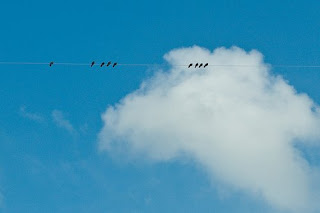 Photo: "one whole note and eight quarter notes" by slowdevil).
Photo: "one whole note and eight quarter notes" by slowdevil).I’m a big stickler for rhythm accuracy. I tell my students that “the right note at the wrong time is still a wrong note.” It’s a Lowe Studio motto. When I studied pedagogy, I learned a cool way to teach rhythm to beginners that remains the most successful activity I’ve used. It was presented in a piano method by Guy Duckworth – I no longer have it, and can’t find it for sale anywhere, but maybe some of you remember it.
You start by having the child set a steady beat with their feet. We do this sitting. Just “march” in place, alternating left and right. With the hands, clap the rhythm of the exercise or the piece, but alternate sides of the body for each beat. For instance, for a string of 4 quarters, clap the first on the left side as the left foot steps that beat, the second on the right side as the right foot steps, the third on the left, and the fourth on the right. You’ll be marching in place, and swinging your clapping hands from left to right. When you clap a half-note, clap on one side, then hold the hands together and swing them to the other side to mark the second beat. A dotted half-note claps on one side, and swings twice, etc. Two-eighth notes are both clapped on the same side.
As we’re doing this marching and clapping, we’re saying the rhythm, too. But, not with ta’s or ti-ti’s. We simply say the name of the note. “Quarter, Quarter, Half-Note.” The two syllables of “quarter” are spoken on the eighth note pulse, and “half-note” is stretched out to cover the 2 beats. For a dotted half note, say “Half Note Dot.” For a whole, “Whole Note Hold It.” For eighth notes, “Two-eighths.” Chanting the name of the note reinforces their vocabulary as well. Later on, we continue to do the physical part but count instead of chanting the note name. Putting the beats on different sides of the body helps them really feel and internalize where all of the notes belong within the large-beat framework, and this is especially helpful when the rhythms become more complicated.
I tell the kids we’re going to do “piano aerobics,” and they enjoy it! I wouldn’t start a child off trying to do this for the first time with all the notes values at once! Start with just quarters to get the coordination down and gradually increase the challenge. Every now and then, I have a student who just isn’t coordinated enough to pull this off, but that’s rare. When it happens, I have them walk the beat and chant the notes without clapping. Or we chant and clap without walking. Sometimes, they can eventually put it all together. This method works well for me – maybe it will help you!
2 comments:
Thank you so much! I have been racking my brain for some new ideas for a student of mine who has some pretty challenging learning disabilities. I think this will really help her. Thank you for taking the time to post it on-line.
Laura...I have 8 copies of Guy Duckworth's book...Keyboard Explorer and four each of the remaining levels, 2-4. Yes, it is a great way to teach beginning rhythm. Was on the internet today to try and find some new copies in a store inventory. So far, no luck. May have to cut mine all apart and put in plastic sleeves. I am in the process of writing a beginning piano teacher aide called "Cookie Party," based on Guy Duckworth's notion of all 12 major patterns, taught early in piano study!
Post a Comment